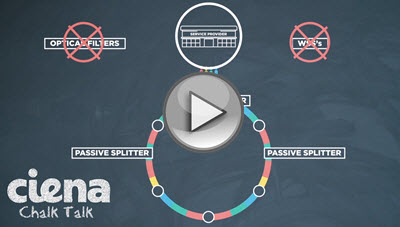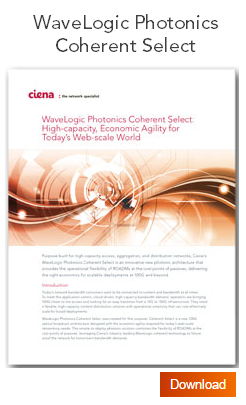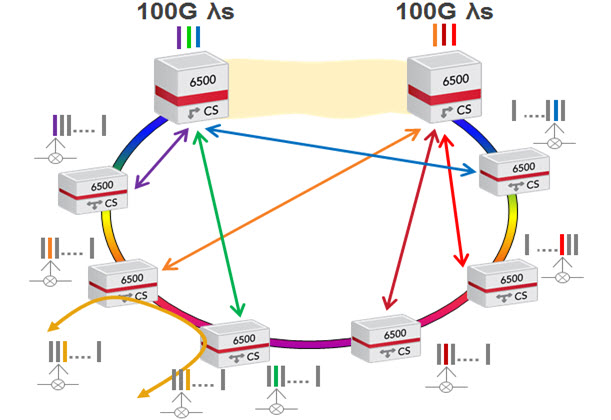The Metro gets a brand new 100G architecture option
This is the fifth in a series of blog posts detailing Ciena’s new products and solutions tailored for a new web-scale world. Other posts in the series:
- Ciena goes web-scale with new coherent, metro and small cell backhaul solutions
- The Web-scale Effect and the Future of Networks
- Ciena’s new coherent chipsets raise the optical bar again
- Scaling big with small cells
2015 has been called the year of Metro 100G. With 100G now pervasive in long-haul networks and traffic growth showing no signs of slowing down, the metro is now the new battleground for 100G deployments.
This is driven by the new web-scale dynamic that is significantly changing the evolution of today’s network architectures, driven by the growing adoption of cloud computing, network virtualization and openness, and the growing market for data center interconnect (DCI).
Today’s two architecture options for metro networks
Traditionally, operators have had to choose between two types of photonic architectures when deploying an optical network: a passive, fixed-filter solution or one that deploys ROADMs. Each has its advantages and drawbacks.
A fixed-filter solution delivers low-cost, simple point-to-point connectivity, but this comes at the cost of significant ongoing operational complexity. Fixed-filter deployments lack flexibility and automation, requiring skilled personnel to perform manual on-site adjustments—with costly test equipment—when adding wavelengths and troubleshooting network problems.
Fixed-filter solutions also can’t scale to meet unpredictable bandwidth demands. They need to be designed from day 1 with pre-defined total capacity and end-to-end connectivity requirements. Consequently, a fixed-filter photonic infrastructure does not offer the photonic flexibility, scalability, or operational simplicity required for today’s web-scale networks.
The other approach is to deploy ROADMs. This option provides a fully agile photonic layer with any-to-any mesh connectivity, as well as remote wavelength re-configurability and increased automation and availability. However, this degree of photonic flexibility and operational simplicity comes at a significant initial cost premium compared to passives, which can deter wide-scale deployments particularly in access, metro, and regional applications.
Using coherent technology to simplify the metro network
 The rise of intelligent coherent optics now offers a third metro architecture option. By leveraging the embedded intelligence of a coherent chipset, a new photonic architecture can be created that provides much of the flexibility of a ROADM-based network but without the need for costly wavelength selective switches (WSS) and optical filters. This provides network operators with the best of both current architectural options: the operational flexibility of ROADMs but at the cost points of passives, and delivers the right economics for scalable deployments at 100G and beyond.
The rise of intelligent coherent optics now offers a third metro architecture option. By leveraging the embedded intelligence of a coherent chipset, a new photonic architecture can be created that provides much of the flexibility of a ROADM-based network but without the need for costly wavelength selective switches (WSS) and optical filters. This provides network operators with the best of both current architectural options: the operational flexibility of ROADMs but at the cost points of passives, and delivers the right economics for scalable deployments at 100G and beyond.
Ciena Coherent Select: a new option for metro networks
This new metro architectural option comes in the form of Ciena’s new WaveLogic Photonics Coherent Select. Coherent Select is a new 100G/200G optical broadcast architecture that uses passive optical units to create a wavelength broadcast and select infrastructure that does not require Wavelength Selective Switches (WSS) or optical filters.
In this architecture, all wavelengths are broadcast throughout the network and are dropped at every OADM site and port. Instead of using a conventional WSS for wavelength filtering and switching , Coherent Select uses the intelligence and frequency selectivity capability of Ciena’s WaveLogic 3 coherent optics to tune to the desired wavelength and reject all other channels – similar to the concept of how a radio operates (see diagram below).
Unlike conventional passive fixed-filter solutions, these wavelengths can go from any site to any site, with any spectral width and centered on any frequency, making the network both flexible and future-proof. Coherent Select also retains many of the operational benefits associated with ROADMs, including automatic real-time power balancing, full photonic topology visualization, and remote wavelength reconfiguration with colorless, directionless and flexible grid capabilities.
 Coherent Select leverages Ciena’s full suite of coherent optics: WaveLogic 3, WaveLogic 3 Extreme and WaveLogic 3 Nano, in conjunction with two new passive modules , the Optical Broadcast and Bridge (OBB) and the Optical Broadband Mux/Demux (OBMD) which operate with all existing 6500 shelf configurations.
Coherent Select leverages Ciena’s full suite of coherent optics: WaveLogic 3, WaveLogic 3 Extreme and WaveLogic 3 Nano, in conjunction with two new passive modules , the Optical Broadcast and Bridge (OBB) and the Optical Broadband Mux/Demux (OBMD) which operate with all existing 6500 shelf configurations.
To be clear, this new Coherent Select architecture is not the choice for all deployment scenarios; it is optimized for hub-and-spoke applications. For example, large mesh-based metro networks are better served by a more traditional ROADM-based architecture. But for high-capacity access and metro aggregation networks in applications such as content distribution, data center interconnect and mobile backhaul, Coherent Select provides a compelling new architecture option for both traditional network operators and new web-scale operators alike.
Want to learn more, download the coherent select white paper.





